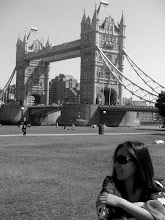Two weeks ago, upon learning that I got the first job I applied for, naturally my heart soared high and I was floating up there in Cloud 9. Not for long, as I realized soon after.
According to one of those immigration rules in Norway with blurred meanings,
a person who came to Norway and obtained a permit to stay and work based on family immigration is not allowed to commute for work or study on a regular basis. A married couple should "live together", literally speaking. This, presumably, is to rule out
pro forma or arranged marriages.
Does this mean that if I'm away from home 2-3 days a week (or a month or year) would make my stay here in Norway illegal? Does this mean that if I move to Stavanger (where my job is), my husband should give up his job and inevitably move with me? Or does this imply that I (as the immigrant) can't commute but he, as a Norwegian citizen, can have more freedom to move around?
Many a time it has been proven that there's a hazy line between the written and hidden meanings of certain rules -- what's explicit and what's implicit.
For instance, a Russian researcher who has lived in Norway for 11 years was recently expelled because she commuted between her home and workplace (which is in a different city). Her punishment was outrageously harsh -- eternal ban from entering Norway and all Schengen countries.
Never mind if we have to move to another city. We have thoroughly thought that over and we gladly welcome the change. We don't mind selling our newly-purchased apartment either. My husband is also willing to give up his stable & interesting job, in worst case scenario.
What frustrates us beyond description, however, is that UDI is a faceless entity. We are unable to get concrete answers from our phone queries. And with different interpretations of rules - most of which can be rigid - we can't take the risks of crossing that certain line of uncertainty.
According to our lawyer, in UDI's eyes,
someone like me with a Filipino passport is a PROSTITUTE, regardless of my educational background or work experience.
Brutal but true. It was tough enough to be occasionally mistaken as a "japayuki" (Filipino entertainer in Japan) while living in Japan. But to be "profiled" according to nationality? That's a completely different matter. I understand there had been countless cases of Asians married to Norwegians through the internet or mail order brides or random meetings in bars. But seriously, can't they be a little bit more impartial and fair? Talking about equality and diversity in this country.
Anyway, I was gonna go on and express all my pent-up emotions on Norway's unnecessary immigration red tape and sometimes irrational (albeit well-intended) laws - at least a little bit more. But then, on the other hand, things are starting to shape up.
Firstly, I got my personal number/social security number within 2 weeks from application date. Now, I'm finally "id'ed" in Norway - my own identification number. Goodbye to my national passport - I won't need to bring it each day I leave the apartment - and "identity" anxieties. Hello to my new bank account, my personal doctor, my tax card, and other opportunities beyond what my brain can absorb.
Thanks heavens to people who are actually working behind the public offices' front desks.
Secondly, the public machinery is functioning well in regards to facilitating our purchase of apartment and relocation -- the bank that lent us the monies, the real estate agency which painstakingly paid attention to details of the paper works, the postal office which effectively diverted our mails to our new address, etc.
For all these notes of hope and "opportunity doors" opened, I remain grateful.
***
Important WebsitesWork, residence, visa, citizenship, etc., see http://www.udi.no/
Taxes, wages, national population registry, see http://www.skatteetaten.no/
Work and labour market, see http://www.nav.no/
Information portal for work migrants and immigrants, http://www.nyinorge.no
Tourist information, see http://www.visitnorway.com
Statistics, see http://www.ssb.no
Customs, see http://www.toll.no

 The first week I moved to Stavanger, the
The first week I moved to Stavanger, the 





